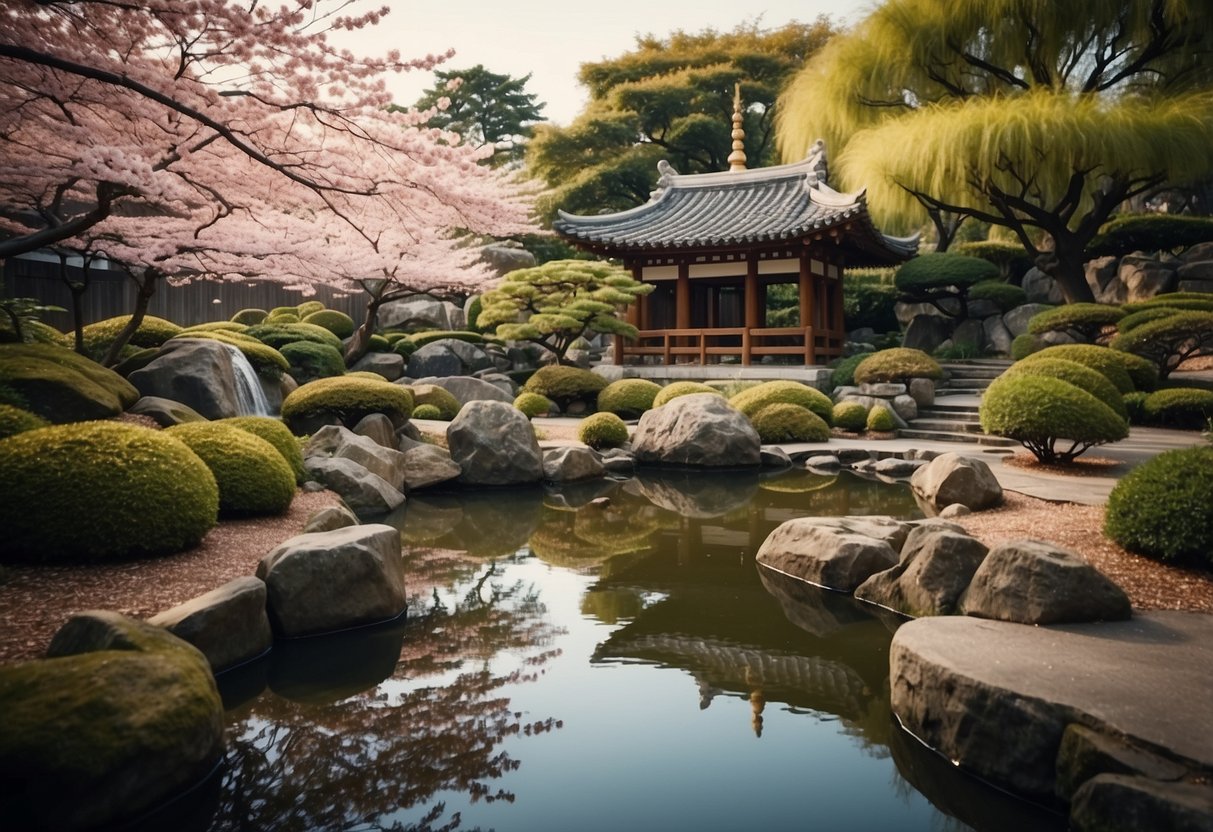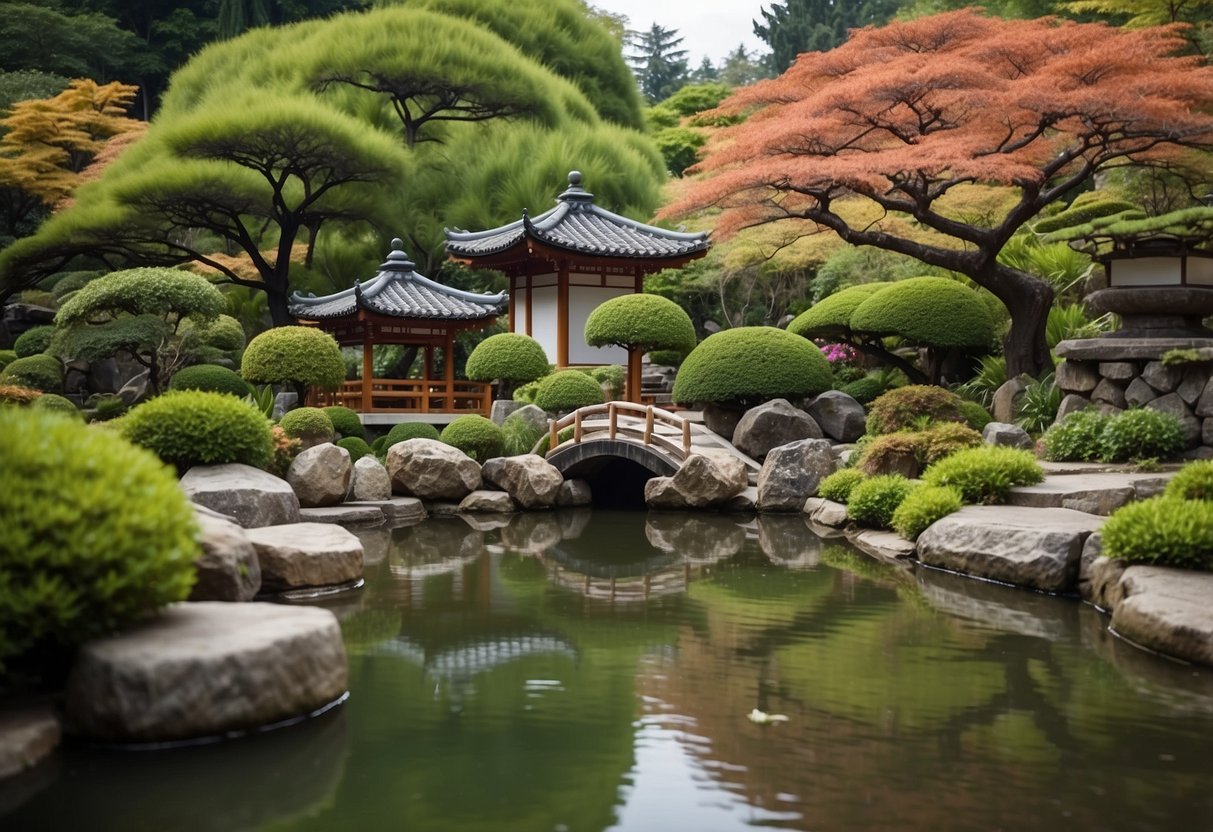Japanese Garden Design Ideas: Create a Serene Oasis
Creating a Japanese garden offers a peaceful retreat right in your backyard. These gardens combine elements like water, rocks, and plants to foster a sense of tranquility and harmony. They draw inspiration from Buddhist, Shinto, and Taoist philosophies, aiming to inspire peaceful contemplation.

Are you looking to transform your garden into a serene escape? Japanese garden design is all about balancing simplicity and natural elements. Whether you have a small space or a large yard, there are plenty of ways to bring a touch of Zen to your outdoor area. By focusing on clean lines, natural materials, and thoughtful placement, you can design a garden that promotes relaxation and mindfulness.
1) Zen Sand Garden

A Zen sand garden is a peaceful retreat right in your backyard. It’s all about simplicity and balance.
Use sand or fine gravel to create patterns that represent water. Rake these patterns into swirls or straight lines for a calming effect.
Place a few decorative rocks to represent mountains or islands. Add small plants sparingly to keep the focus on the sand.
2) Bamboo Fence

A bamboo fence can add a serene and natural look to your Japanese garden.
You can use vertical bamboo canes tied together with black twine. It’s simple yet elegant.
For a sturdier option, you can attach bamboo canes to wooden posts.
Experiment with the height and style to suit your garden’s aesthetics.
3) Koi Pond

A koi pond can add a peaceful element to your Japanese garden. Koi fish are colorful and calming to watch. They come in various shades like blue, yellow, red, and white.
You can design your koi pond with a stone bridge for a traditional look. A water wall or a raised edge adds visual interest. Include some plants like ferns around the pond to enhance its beauty.
Consider incorporating stepping stones or a seating area nearby. This allows you to relax while enjoying the serene movements of the koi fish. A well-designed koi pond can be a focal point in your garden. For more ideas, visit koi pond design ideas.
4) Stone Lantern

You can add a unique touch to your garden with stone lanterns. These lanterns, or “toro,” have been part of Japanese gardens for centuries. They can create a serene atmosphere with their soft glow.
There are different types of stone lanterns, like the Yukimi-Gata, which have legs and are also known as snow-viewing lanterns. These lanterns can stand on long cylindrical or low platform bases.
Placing stone lanterns along pathways or near water features can enhance your garden’s charm.
5) Cherry Blossom Trees

Cherry blossom trees are a beautiful addition to any Japanese garden. These trees are known for their stunning spring blooms, which can create a picturesque scene.
You can choose from various types, like the Japanese Cherry Blossom (Prunus serrulata), which is popular for its bright, showy flowers.
Plant cherry blossom trees in well-drained soil and a sunny spot to see them thrive in your garden.
6) Stepping Stones

Stepping stones add charm to a Japanese garden. They create a mindful path for you to walk on and enjoy the scenery.
Choose stones that feel smooth under your feet. It enhances the peaceful experience.
Consider a curving path of stepping stones to guide you through your garden, encouraging relaxation and mindfulness.
7) Tea House

A tea house, or chashitsu, brings a serene focal point to your garden. This structure is perfectly built for relaxation.
Choose a quiet spot in the garden, ideally surrounded by trees or plants. Make sure you have a good view of nature.
Inside, keep the design simple and rustic, aligning with traditional Japanese aesthetics. This setup will help you create a peaceful retreat right at home.
8) Moss Ground Cover

Moss is a classic element in Japanese gardens. It brings a serene and calming vibe to the space. Aside from its aesthetic appeal, moss is relatively low-maintenance.
Moss thrives in shady and moist areas, which makes it ideal for gardens with lots of tree cover or shaded spots. It grows well on rocks, stones, and even on soil.
Including moss can make your garden feel more connected to nature. It acts as a soft, green carpet that contrasts beautifully with harder elements like rocks and pathways.
For more ideas, check out these serene Japanese moss garden ideas.
9) Tsukubai Water Basin

The Tsukubai water basin is a key element in Japanese garden design. It’s a shallow stone basin often used for ritual cleansing, symbolizing the purification of mind and spirit.
Typically, a bamboo water scoop lies across the top, ready for use. This feature adds a serene touch to the garden, inviting calm and reflection.
Including a Tsukubai in your garden helps create a peaceful atmosphere. Water gently flowing into the basin provides a soothing sound, enhancing the overall tranquility.
Learn more about creating your own Tsukubai Japanese Water Garden here.
10) Maple Trees

Maple trees add a touch of beauty to any Japanese garden. They come in many shapes and sizes, perfect for different garden spots.
Some maples turn orange or gold-yellow in fall, adding vibrant colors. They make great companions to azaleas and hydrangeas.
Many Japanese maples grow slowly and reach 10 to 15 feet tall. This makes them suitable for beds, borders, and even containers. Adding these trees can create striking focal points in your garden, especially with their elegant foliage.
For more inspiration, check out this designing with Japanese maples article.
Traditional Japanese Garden Elements

Traditional Japanese gardens include unique elements like stones, gravel, water features, and various plants and trees. These components work together to create a calm, balanced environment that encourages reflection and peace.
Stones and Gravel
Stones and gravel play a significant role in Japanese gardens. Large stones often symbolize mountains or islands and are carefully placed to create balance. Gravel is used to represent water in dry gardens (karesansui). You might recognize the raked patterns in gravel, which symbolize waves and are designed to inspire meditation. This combination of stones and gravel provides a strong, natural foundation for the garden, influencing the overall mood.
Water Features
Water features such as ponds, streams, and waterfalls add a dynamic element to Japanese gardens. Ponds may house koi fish, symbolizing longevity and good fortune. Streams and waterfalls create soft, soothing sounds, enhancing the sense of tranquility. Some gardens also include stone lanterns near these features for aesthetic and symbolic purposes. These water elements draw the eyes and ears, promoting a mindful connection with nature.
Plants and Trees
Plants and trees in Japanese gardens are selected for their aesthetic and symbolic meanings. Common choices include Japanese maple, cherry trees, bamboo, and moss. These plants are often pruned meticulously to maintain their shape and to highlight their natural beauty. Seasonal flowers like azaleas and chrysanthemums may be included for bursts of color. The careful selection and maintenance of these plants emphasize the garden’s connection to the natural cycles of life.
Design Principles

Understanding the key principles of Japanese garden design can help you create a peaceful and harmonious space. These gardens focus on balance, harmony, and the thoughtful use of space to evoke a sense of calm.
Balance and Harmony
In Japanese garden design, balance and harmony are crucial. You aim to create a natural look where all elements, like rocks, plants, and water, work together seamlessly.
Balance doesn’t always mean symmetry. Instead, it’s about asymmetrical arrangements that feel natural and organic. For example, placing a large rock on one side can be balanced with a cluster of smaller plants on the other.
Harmony comes from using natural materials and muted colors. Avoiding straight lines and perfect shapes, you use curves and irregular forms to mirror nature.
Shapes and sizes should vary to avoid monotony. A balance between empty space and filled space helps keep the eye moving and the mind engaged.
Use of Space
Japanese gardens make intentional use of space to create a serene atmosphere. Empty spaces, also called negative spaces, are just as important as filled areas.
Negative space gives the eye a place to rest. It emphasizes nearby elements, making the garden feel peaceful and uncluttered. For instance, a patch of moss or gravel can accentuate a large stone or a small pond.
You should arrange elements to guide visitors through the garden. Paths should not be straight but meandering, encouraging a slower, more reflective walk.
Use layers and different heights to add depth. A tree might be in the background, shrubs in the middle ground, and moss in the foreground, creating a sense of depth and distance.
Paying attention to these principles will help you design a garden that feels natural, balanced, and harmonious.
Modern Adaptations

Modern Japanese garden designs incorporate current trends and eco-friendly practices that add a fresh twist to traditional elements. This section explores how contemporary materials and sustainable methods can transform your garden.
Incorporating Contemporary Materials
Using modern materials can give a traditional Japanese garden a fresh and unique look. For instance, integrating black painted walls or charred timber can create striking backdrops that highlight other garden features. Porcelain paving tiles can also add a sleek, polished feel to pathways and sitting areas, making your garden look both elegant and modern.
Incorporating geometric patterns with different colored stones can add a touch of contemporary art to your garden design. These patterns can create intriguing visual contrasts while maintaining the garden’s serene vibe.
Modern materials like steel and glass elements can be skillfully blended with traditional wooden structures. This fusion of old and new adds depth and character, creating a garden space that’s both timeless and trendy.
Sustainable Practices
Sustainable practices in Japanese gardens help you create a beautiful space while being kind to the environment. Native plants are crucial as they require less water and care, making your garden more eco-friendly. Additionally, they attract local wildlife, promoting biodiversity.
Incorporating water-saving features like rainwater harvesting systems is another practical move. You can use collected rainwater for your garden, reducing your dependence on municipal water supplies.
Using recycled materials wherever possible is another way to promote sustainability. This includes repurposing old stones, wood, and even metal. Not only does this cut down on waste, but it also brings a unique character to your garden design.
Creating a compost system right in your garden can provide natural fertilizers, helping your plants thrive without harmful chemicals. These sustainable practices ensure that your Japanese garden remains beautiful and environmentally responsible.







